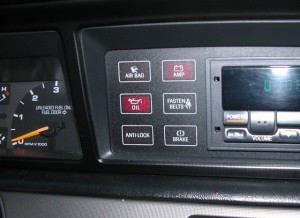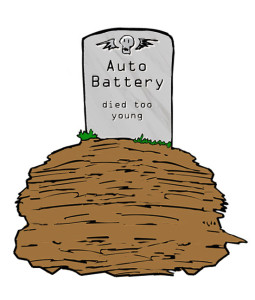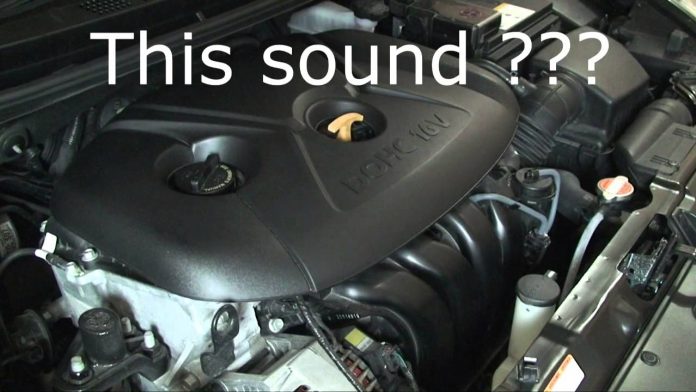If your car’s engine starts making a “funny noise,” should you be worried?
It depends on the noise.
Some noises are harbingers of real trouble. Others are usually nothing to worry about. But how do you tell the former from the latter?
Let’s take a look at some examples of both kinds of noises:
Ticking sound when you first start the engine –
A light ticking sound that goes away within seconds after the engine is first started after it’s been sitting overnight (or longer) is usually no cause for concern . . . provided it’s light and that the sound goes go away within a few seconds, once the engine is running.
What’s happened is all the oil has settled to the very bottom of the engine. It takes a moment for the running engine to build oil pressure. The noise you hear should go away as soon as the system is pressurized.
So, this noise is normal, provided it is very brief and provided you only hear it at cold-start, when the engine has been sitting for awhile. It is most common on cold mornings, when the car has been left outside all night. The oil is thicker and harder to pump, due to the cold.
If the clattering sounds does not go away a few seconds after start-up – especially if it’s present when the engine is fully warmed up – it could be a more serious problem.
And the first thing you should do is turn the engine off.
The next thing you should do is check oil level. Pull out the dipstick and look at the hashmarks. If it’s low, that could be the cause of the trouble. If it is low – and the noise goes away once the level is topped off – you found the problem and cured it. But remember to find out why it’s low. There is either a leak – look for puddles underneath the car after it’s been sitting overnight – or the engine is burning oil excessively. All engines use some oil, but if there isn’t an underlying mechanical problem – or a leak – it should not be necessary to add more than a quart more often that once every six months. If it is necessary, you might want to try to find out why.
If the oil level is not low, the next thing to check is oil pressure.
If the car has a gauge in the instrument cluster, take a look at it while the engine is idling. Never rev the engine if you suspect mechanical problems, especially lubrication related mechanical problems. The gauge should be reading something above zero. In general, at least 15 pounds – but so long as it’s not nothing.
If it is nothing – if the needle doesn’t move – shut the engine off.
Have the car towed to a shop you trust. Do not drive it. Do not run the engine at all until the problem is found and fixed. It might just be a bad sending unit; this is what makes the oil pressure gauge – or oil light – work and if the sender is kaput, the gauge may register no oil pressure or the oil light may come on and stay on even though there is oil pressure. But it’s smart policy to assume there isn’t oil pressure if the gauge says there isn’t – or the light comes on and stays on. Worst case, its a false alarm – and $100 for a tow. As opposed to $5,000 for a new engine because the one you had fused into a lump of junk because you ran it with no oil pressure.
Clicking sound as you drive –
This is usually something stuck in one of the car’s tires. It is almost certainly something stuck in one of the car’s tires if the clicking sound gets faster as the car is driven faster and slows down as the car does.
Hopefully, it is something harmless – a pebble in the tread. When you find it, use something not sharp to wedge it out of the tread and the noise should be gone. But you may find a nail in one of the tires. In which case, leave it alone until you can get the car to a tire shop. That noise is annoying but the nail is also plugging the hole it made in the tire. The hole will need to be plugged with something else once the nail is removed – assuming you want to keep moving.
Squealing and screeching noises –
Several possibilities here, but the most typical are drive belt troubles (loose or misaligned) or accessory troubles such as a problem with the power steering pump caused by low fluid level. Often, the noise will get worse if you rev the engine. Sometimes, the noise is constant. Sometimes, it comes – and goes.
First thing to do is stop the engine, pop the hood and have a look. Check for signs of leaks and seeps around the power steering pump. This accessory is the only accessory that will have a fluid reservoir with a removable cap or dipstick. If you see signs of leakage – and reddish fluid -the usual color of power steering fluid – it’s a clue your problem may be a failing power steering pump. Or failing power steering pump hydraulic lines. If fluid is leaking because of failing lines, the pump will eventually run low, then dry – and it will squeal. Check the fluid level of the reservoir. If it’s low, you’ve likely found your trouble. Topping it off should quiet the squeal . . . until the pump runs low again. You’ll need to have it looked at, but it’s usually not a “right now” thing. Keep spare fluid at the ready for top-offs until you can find time to have the pump (and lines) checked out.
If the power steering pumps seems leak-free and is properly topped off, the next most likely culprit responsible for a case of The Squeals is a loose or misaligned drive belt (or pulley). A quick test that requires no tools is to buy a can of WD-40 aerosol lubricant and – with the engine idling – direct a light spray at the various pulleys and belts (most modern cars have just one serpentine belt that drives all the accessories). If the squeal goes away, you’ve found your problem – and the shot of WD-40 might even permanently cure it.
If not, it’s time to check the condition and tension of the belt – as well as the condition of the tensioner, which (in cars with serpentine belts) is a thing that looks like a pulley without any accessory attached to it. The tensioner’s job is to maintain the correct . . . tension. If it doesn’t, the belt will squeal in protest – and may even fail or slip off the pulleys, if it’s not tensioned properly.
A squealing belt is more an annoyance than an emergency, but be aware that if a drive belt fails, you will lose the accessory it drove. For example, if the belt which drives the AC compressor fails, you won’t have AC anymore. And if the belt which drives the alternator goes, then you won’t have electricity, soon – once the battery runs out of it. You can drive for awhile, but don’ t drive longer than it takes to get to a shop or other such where you can deal with this problem. Running the car on battery power will suck the battery dead – and leave you stuck.
If your car has a serpentine belt, you will lose all accessories – including the water pump, without which the car will overheat in minutes.
A click noise – followed by no noise at all –
This is usually one of two things: Either a bad battery – or a bad connection. The battery might not have sufficient power to turn the starter motor, which starts the engine.
Or, there’s insufficient voltage – as determined by the car’s computer – to power the fuel injection system and the computer calls a halt to things.
First thing to try is checking the connections at the battery. Feel by hand whether they’re loose; sometimes, jiggling them will result in a “lights on” (and ready to start) condition, like magic. But it’s not magic. You’ve just uncovered a poor connection – and re-established a good connection.
You will probably need to either tighten the cable clamps at the battery terminals, or replace the cables, if the clamps have lost their ability to tightly grip the battery’s terminals It may also be necessary to clean the terminals (and cable clamps). Use a wire brush/terminal cleaning tool for this – which you can buy at any auto parts store for about $10. Once clean, spray the terminals/clamps with WD-40, which will displace any lingering moisture (“WD” stands for water displacement) and also leave a protective coating on the exposed surfaces.
If jiggling the wires – and cleaning the connections at the terminals – doesn’t do anything and the battery is more than three years old, the next most likely culprit for your no-start blues is the battery itself. But don’t chuck it before you test it.
Most auto parts stores (NAPA, Auto Zone, Pep Boys) will do this for free – and if the battery is dead and died prematurely you should be able to get at least some of your money back in the form of a store credit toward your new battery.
Assuming you saved the receipt for your old battery.
. . .
Got a question about cars – or anything else? Click on the “ask Eric” link and send ’em in!
If you like what you’ve found here, please consider supporting EPautos.
We depend on you to keep the wheels turning!
Our donate button is here.
If you prefer not to use PayPal, our mailing address is:
EPautos
721 Hummingbird Lane SE
Copper Hill, VA 24079
PS: EPautos magnets are free to those who send in $20 or more. My latest eBook is also available for your favorite price – free! Click here. If you find it useful, consider contributing a couple of bucks! 












I just had to replace the battery on the SUV. I normally replace them on a 3 year schedule because I hate being stranded, but this one died a few months before that.
What I suspect happened is that I go over a lot (a LOT) of speed-bumps each day driving to the new job. And it’s likely that one of the impacts knocked a portion of one or more of the lead plates inside the battery off. It fell to the bottom of the battery and either significantly reduced it’s capacity, or shorted out a couple of cells (12V automotive batteries typically have six cells of 2v each).
I picked up a new one at the dealer – only $20 more than AutoZone, but it came with a 7 year warranty instead of the typical 3 year one. Worth it — even if they tried to up-sell me on new wiper blades while I was there.
To address the lack of oil in a cold engine some makers use oil filters with a one-way valve to keep oil from draining out of the filter but most of those are on vehicles where the filter doesn’t mount up and down but sideways or some angle that doesn’t keep the filter full. I found out just by installing a filter with a check ball that it will hold the oil up in the engine so I always find a check valve filter to fit whatever I’m driving. I also use Amsoil filters that are better than almost all other brands…..almost all. You can figure out which ones are best generally by price. Wix and Purolator make excellent filters too….for just about any application. I also change to a larger oil filter if there’s room which isn’t always the case. It kinda chaps my ass that some 4WD pickups don’t have room for a full quart oil filter. I’m not above installing a pre-oiler kit on a vehicle either. You can get them in manual mode or automatic so that it delivers pressurized oil the moment you turn on the key. That’s probably one of the best things you can add to any vehicle to enhance engine life. Out of all the cheap filters, probably AC and the Ford version are better but neither will compare to high end filters and Fram is just a good way to let big crap keep going around and around. If you doubt this, get a handful of filters and cut the can off at the base and look at what’s inside. They are definitely not all made the same.
As for battery terminals getting corroded, one answer to stop that is by using Optima or similar style batteries. The terminals stay clean for the life of the battery. I had two sets of diesel Optima batteries go 8 years each. It’s nice to not have to service them as well as never having corrosion problems.
My new Focus has an oil temperature gauge, oil pressure gauge, and a coolant temperature gauge. All those are bullshit. Oil pressure is inferred from oil temperature and RPM, there’s no sensor. Oil temperature is inferred from coolant temperature, there is no thermometer for oil. The coolant temperature gauge goes to the middle immediately and stays there, irrespective of coolant temperature. Effectively, each of those gauges shows a different take on coolant temperature. If I log it via OBD-II, it has reasonable values, but the gauges all lie.
What is the purpose of “feel good” gauges that show everything is ok, but don’t reflect reality? My car feels like a politician sometimes.
Is that the focus that has the air filter located in a one piece assembly so that you cannot access the air filter? And that cost $400 to replace with a similar one piece unit?
What? That’s insane. I never knew anyone would do that. No, mine has a bit filter up front that’s easy to reach.
Lol! The 1st time I discovered one of those filters in one of my customer’s cars, I almost couldn’t believe it. To make things worse, his had been shattered near the bottom and was full of water and ice. I managed to haul it out, dry it it out, and patch it up. I think at the time the dealer price was around $750.00. Thankfully it was a one-off option that I have only found one one or two of, out of a hundred, and seems to have been abandoned. Unfortunately I have not found a retrofit from any other model to substitute. Talk about disposable engineering…is this what Ford considers one of their “better ideas”?
That would be a “feature” of the Chevrolet Vega. Doesn’t cost $400 to replace, though. (Maybe the modern version on the Focus does.)
https://www.ebay.com/itm/CHEVY-VEGA-CONCOURS-NOS-SEALED-AIR-FILTER-CLEANER-A-541-C-FA-604-/251280737188
Yep, most “gauges” are now really glorified dummy lights.
That’s because the Auto companies are run by politicians. That’s very interesting about how oil pressure is inferred from engine RPM and temperature. What a load of crap. I guess it just costs automakers too much to provide a real time sensor rather than have the computer crank out continuous calculations. Throw it in the woods. You would think that the costs of software is a lot more than the 89 cents it costs to manufacture the sensor.
Can’t Ford be sued for faulty gauge design that could potentially be a “safety” issue? Not to mention junking the car if it is allowed to run dry while the oil gauge shows no problems.
The cloverian majority don’t know how the real gauges are supposed to behave so they take their cars in for warranty service believing there is something wrong with them.
The typical Ford oil pressure gauge of the last 20 years has been an on/off pressure switch. If there is the minimum pressure it closes and the gauge goes somewhere in the middle. Coolant temp in my Fords has been the actual coolant temp. There’s always a coolant sensor for OBD2 and sometime after 1997 there was a cost reduction to one coolant sensor. My ’97 has two. One for OBD2 one for the gauge as I recall.
Clean terminals and good spark plugs do in fact help your car run more efficiently. 7 year old Xterra had a sliver-of-rust washer and wing nut holding the connector on the battery. Replaced with a bronze marine/boat terminal. Sounds, drives, and performs like new now. Keep em clean. When cleaning doesn’t help anymore, replace it.